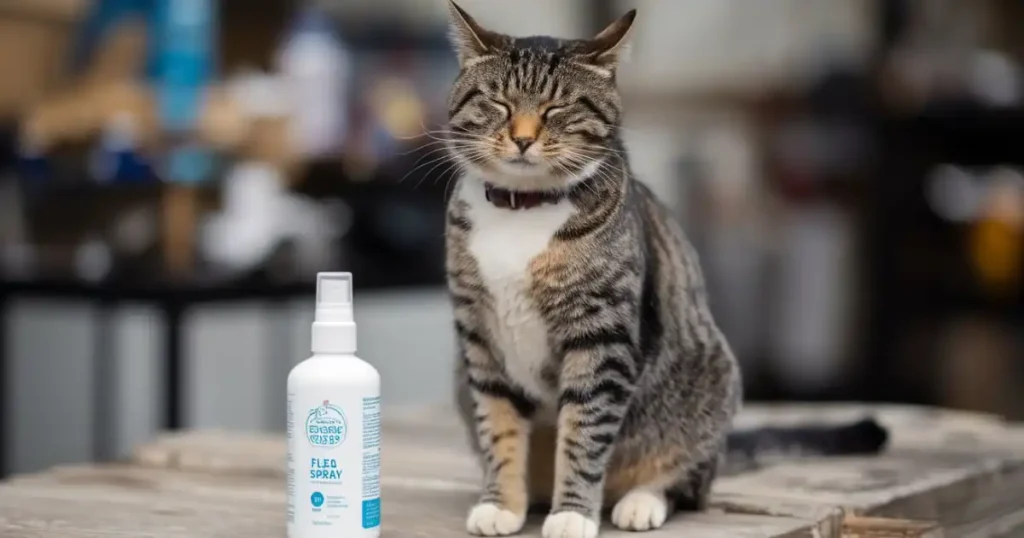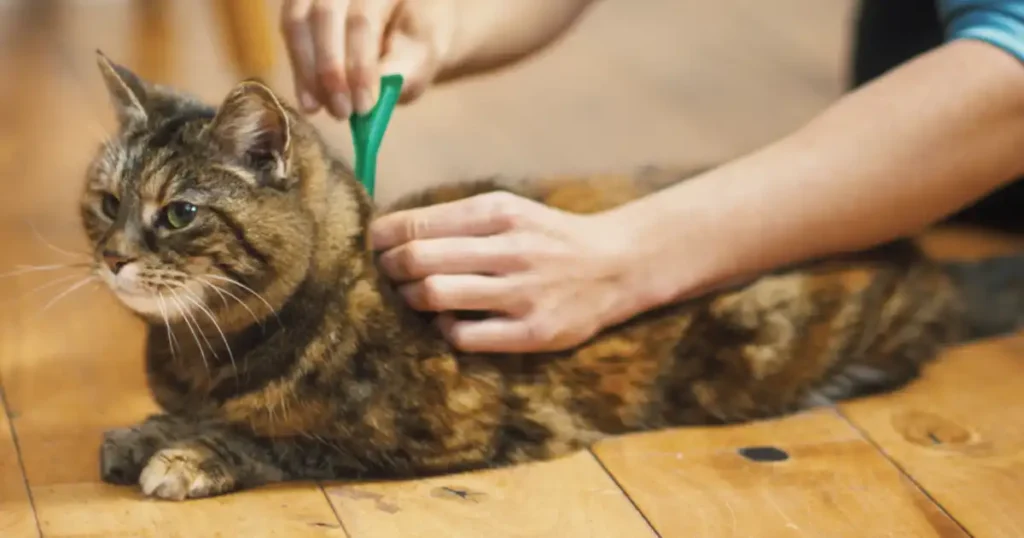
Cats and their owners may experience significant discomfort from flea infestations. These tiny parasites cause itching, skin irritation, and can even transmit diseases. Effective flea spray for cats provide a convenient and quick solution for eliminating fleas on cats and preventing reinfestation.
Selecting the best flea spray is essential to protecting the health and comfort of your feline companion. There are plenty of options on the market, from potent chemical formulations to natural ingredients. While some sprays concentrate on instantaneous flea elimination, others provide long-lasting protection.
It's crucial to take the cat's age, health, and any current skin issues into account when choosing a flea spray for cats. The most important factors are safety and effectiveness because improper use of some ingredients can be dangerous to cats. Veterinary advice can be very helpful in assisting cat owners in selecting the best flea spray for cats.

Fleas pose significant health threats to cats and can quickly infest homes. These microscopic parasites are a recurring issue for pet owners because they feed on the blood of felines and multiply quickly.
There are four life stages for fleas: the egg, larva, pupa, and adult. Flea eggs laid by adult cats fall into the surrounding environment. These eggs take two to twelve days to hatch into larvae. Larvae consume organic waste and the excrement of adult fleas.
After 5-11 days, larvae spin cocoons and enter the pupal stage. Pupae can hibernate for several months before becoming adults in response to stimulation from heat, carbon dioxide, or vibration. When adult fleas emerge, they immediately look for a host.
Adult fleas begin feeding on a cat within minutes of finding a host. Female fleas can lay up to 50 eggs per day. This rapid reproduction cycle allows flea populations to explode quickly.
In cats, fleas can lead to a variety of health problems. Flea bites frequently cause excruciating itching and scratching, which may cause skin irritation and hair loss. An allergic reaction to flea saliva is known as flea allergy dermatitis in certain cats.
Heavy flea infestations may cause anemia, especially in kittens or debilitated cats. Fleas can transmit tapeworms when cats ingest them while grooming. These parasites can also spread diseases like bartonellosis (cat scratch fever) to humans.
Flea spray cats can be an effective tool in combating these pests. It helps break the flea lifecycle by killing adult fleas and preventing egg development. Regular use of flea spray, combined with other preventive measures, can protect cats from these harmful parasites.

Flea sprays for cats come in various formulations to suit different needs and preferences. These products can be broadly categorized into chemical-based, natural, and prescription options.
Chemical-based flea sprays for cats often contain synthetic insecticides. These products typically offer fast-acting and long-lasting protection against fleas. Common active ingredients include pyrethrins, pyrethroids, and fipronil.
Adult fleas can be effectively killed by pyrethrins, which are derived from chrysanthemum flowers. Synthetic pyrethroids are meant to be more durable and stable than pyrethrins. Fipronil rapidly eradicates infestations by interfering with the nervous system of fleas.
Many chemical-based flea sprays also contain insect growth regulators (IGRs) like methoprene or pyriproxyfen. These compounds prevent flea eggs and larvae from developing into adults, breaking the flea life cycle.
Natural flea sprays for cats use plant-based ingredients to repel and eliminate fleas. These products appeal to pet owners seeking alternatives to synthetic chemicals.
Common natural ingredients include:
Natural flea sprays often work by creating an environment that fleas find unappealing. Some ingredients, like diatomaceous earth, can physically damage flea exoskeletons.
While generally considered safer, natural sprays may require more frequent application.It's crucial to remember that when used incorrectly, some essential oils can be toxic to cats.
Prescription flea sprays for cats are available only through veterinarians. These products often contain stronger or newer active ingredients that haven't been approved for over-the-counter use.
Prescription sprays may offer:
Over-the-counter flea sprays are readily available at pet stores and online retailers. These products provide a convenient option for routine flea prevention and treatment of minor infestations.
OTC sprays typically contain well-established ingredients with known safety profiles. They come in various formulations, including water-based and alcohol-based options.
The health of your cat, the frequency of fleas in your area, and any issues with flea resistance should all be taken into account when deciding between prescription and over-the-counter flea sprays.

Selecting an effective and safe flea spray for your cat requires careful consideration of ingredients and formulation. Cat owners should prioritize products that are specifically designed for felines and avoid those intended for dogs or other animals.
While being kinder to cats, natural ingredients like peppermint, cedarwood, and lemongrass oils can be effective against fleas. Because of their insecticidal qualities, pyrethrins, which are derived from chrysanthemum flowers, are frequently found in flea sprays. Insect growth regulators (IGRs), such as methoprene or pyriproxyfen, are present in certain products and stop flea eggs from hatching.
Fipronil is a synthetic insecticide found in many flea sprays. It works by disrupting the flea's nervous system. Neem oil, a natural substance, can repel fleas and is often included in organic formulations.
To find out the concentrations of the active ingredients, always read the label. Although there is a chance of negative effects, higher concentrations might be more beneficial.
Cats with sensitive skin or allergies require extra caution when choosing a flea spray. Hypoallergenic formulas are available and may contain fewer harsh chemicals. Avoid sprays with strong fragrances or alcohol, as these can irritate a cat's skin and respiratory system.
Water-based sprays are generally milder than alcohol-based ones. Some cats may react poorly to certain essential oils, so it's wise to test a small area before full application. Consult with a veterinarian before using any flea product on kittens, pregnant, or nursing cats.
For extremely sensitive cats, consider non-spray alternatives like flea combs or oral medications prescribed by a vet. Always monitor your cat for any adverse reactions after applying a new flea spray.

Proper application of flea spray is crucial for its effectiveness and your cat's safety. Follow these guidelines to maximize results and minimize risks.
To start, give your cat's coat a good brushing to get rid of any loose fur and debris. Before using, give the flea spray bottle a good shake. Keep the spray bottle between six and twelve inches from your cat's body.
Begin spraying at the head, working your way down to the tail. Avoid the eyes, nose, and mouth. Use your free hand to ruffle the fur, ensuring the spray reaches the skin.
Pay extra attention to areas where fleas often hide:
For long-haired cats, part the fur as you spray to improve coverage. Repeat the process on the cat's belly and legs.
Prior to usage, always carefully read the product label. Check for allergic reactions by doing a patch test on a tiny patch of your cat's skin.
Since dog flea products can be toxic, never use them on cats. After applying, prevent your cat from grooming itself for at least half an hour.
Spray away from flammable materials to prevent fume inhalation. Put on gloves to shield your skin from the spray's direct contact.
Should your feline exhibit indications of discomfort, promptly remove the product and get in touch with your veterinarian. Keep the spray out of children's and animals' reach.

Effective flea control requires a multi-faceted approach. Flea spray for cats plays a crucial role when combined with other treatments and incorporated into a regular maintenance routine.
Anti flea spray for cats works best when used alongside other flea control methods. Apply the spray after giving your cat a flea bath or using a flea comb. This combination helps eliminate both adult fleas and their eggs.
For severe infestations, consider using flea spray in conjunction with oral flea medications prescribed by a veterinarian. This dual approach targets fleas at different life stages.
Treat your home environment simultaneously. Use household flea sprays on carpets, furniture, and pet bedding. Vacuum thoroughly before and after applying treatments to remove flea eggs and larvae.
Incorporate flea spray into a consistent prevention routine. Apply the product monthly or as directed by the manufacturer. Mark application dates on a calendar to maintain a regular schedule.
Even when taking preventative measures, routinely check your cat for flea infestations. Once a week, go through their fur with a flea comb, being especially careful around the base of the tail and the neck.
Every week, give your cat's bedding a hot water wash. Regularly vacuum floors and furniture, making sure to dispose of the vacuum bag and its contents in a plastic bag that is sealed.
To keep your yard looking neat, mow the grass and clear any areas where fleas could hide. If your cat spends a lot of time outdoors, think about applying pet-safe outdoor flea treatments.
Effectively treating your home and living spaces is crucial for controlling flea infestations. Proper application of flea sprays can help eliminate these pests from furniture, bedding, and other areas where cats frequent.
Flea sprays designed for home use contain insecticides that target adult fleas and their larvae. These products often include ingredients like pyrethrins or permethrin, which are effective against fleas.
Before applying flea spray, thoroughly vacuum all carpets, upholstery, and crevices. This step helps remove existing fleas and their eggs.
When using flea spray for cats and furniture, ensure all pets and people are out of the room. Follow the product instructions carefully, paying special attention to dosage and application methods.
On carpets, rugs, and upholstered furniture, evenly spray the product. Treating pet bedding is important because fleas frequently live in these places.
Before reintroducing pets or people, let the treated areas completely dry. This usually takes two to four hours, depending on the ventilation and product.
Repeat the treatment as directed on the product label, usually every 2-4 weeks, to break the flea life cycle effectively.
Regular flea checks are crucial for maintaining your cat's health and comfort. Early identification enables timely treatment, stopping the spread of infestations.
Excessive scratching or grooming is a common indicator of fleas. Cats may lick or bite their fur more frequently, particularly in the area around their hind legs and tail base.
Check your cat's fur for tiny, dark spots. These particles of "flea dirt" are actually the droppings of fleas. If they turn reddish-brown when placed on a damp white paper towel, it indicates that fleas are present.
Check your cat's skin for small, red bumps or scabs. These are often signs of flea bites and subsequent scratching. Parting the fur can reveal live fleas moving on the skin.
Hair loss or bald patches may develop due to intense scratching. In severe cases, cats might experience lethargy or appear anemic from blood loss.
Consult a veterinarian if you notice persistent scratching or visible fleas despite using flea spray for cats. Professional guidance ensures proper treatment and prevents complications.
Seek immediate veterinary care if your cat shows signs of flea allergy dermatitis. Symptoms include intense itching, skin inflammation, and scabs.
Kittens, elderly cats, or those with health issues may require prompt medical attention when infested with fleas. These groups are more susceptible to flea-related complications.
A vet visit is necessary if you observe signs of tapeworms, as fleas can transmit these parasites. Look for small, rice-like segments in your cat's feces or around their anal area.
In the US, flea control product registration and regulation are managed by the Environmental Protection Agency (EPA). Manufacturers must submit extensive data on product safety and efficacy before receiving EPA approval.
EPA-approved flea sprays must meet strict standards for ingredients, labeling, and usage instructions. The agency requires clear warnings about potential risks and proper application methods on product packaging.
Flea sprays containing pesticides are classified as either general use or restricted use products. General use products are available to consumers, while restricted use products can only be applied by certified professionals.
The EPA maintains a database of registered flea control products, allowing consumers to verify a product's approval status. Regular reviews ensure continued compliance with safety standards and environmental regulations.
Flea sprays for cats can raise many questions for pet owners. Proper usage, safety, and effectiveness are key concerns when choosing and applying these products.
When using flea sprays indoors, remove pets and people from the area. Open windows for ventilation and cover food and water bowls.
Spray furniture, carpets, and pet bedding lightly. Allow surfaces to dry completely before letting pets or people back into the treated areas.
Vacuum thoroughly after treatment to remove dead fleas and eggs. Repeat application as directed on the product label.
Some natural flea sprays containing essential oils like cedarwood or lemongrass can be safe for cats when used properly. Always check the ingredients and consult a veterinarian before use.
Dilute essential oils appropriately and avoid spraying directly on cats. Natural remedies may be less effective than chemical treatments but can offer a gentler alternative for sensitive pets.
Isolate the infested cat from other pets. Bathe the cat with a flea shampoo to remove visible fleas and eggs.
Apply a veterinarian-approved flea treatment. Wash all bedding and vacuum the entire house, disposing of the vacuum bag immediately.
Even if your pet doesn't exhibit any flea symptoms, you should still treat them all. For severe infestations, think about hiring a pro pest control company.
Monitor your cat for reduced scratching and grooming behaviors. Check for a decrease in visible fleas on the cat's fur and bedding.
Use a flea comb to inspect for live fleas or flea dirt. You may notice dead fleas falling off your cat after treatment.
Continue regular checks for several weeks, as flea life cycles can take time to fully disrupt.
Homemade flea sprays using ingredients like vinegar, lemon juice, or essential oils can be made. These DIY solutions may repel fleas but are generally less effective than commercial products.
Store-bought flea sprays contain specific insecticides designed to kill fleas at various life stages. Homemade alternatives lack these targeted ingredients and may not provide complete protection.
Critter Stop offers professional pest control services for homeowners dealing with flea infestations. Their experienced technicians use safe and effective methods to eliminate fleas from homes and yards.
To schedule a free inspection, residents can call Critter Stop at (214) 234-2616. The company's experts will assess the flea problem and recommend an appropriate treatment plan.
Critter Stop has built a strong reputation for high-quality work and excellent customer service. Many satisfied clients have shared positive reviews online, praising the company's thorough and effective pest control solutions.
When contacting Critter Stop, homeowners should be prepared to:
The company's technicians will answer questions and address concerns about the flea removal process. They can also offer advice on preventing future infestations.
Prompt action is crucial when dealing with fleas. Contacting Critter Stop for a free inspection is an important first step in reclaiming a flea-free home and protecting pets from these troublesome pests.
Visit our Critter Library and learn more about our furry friends







